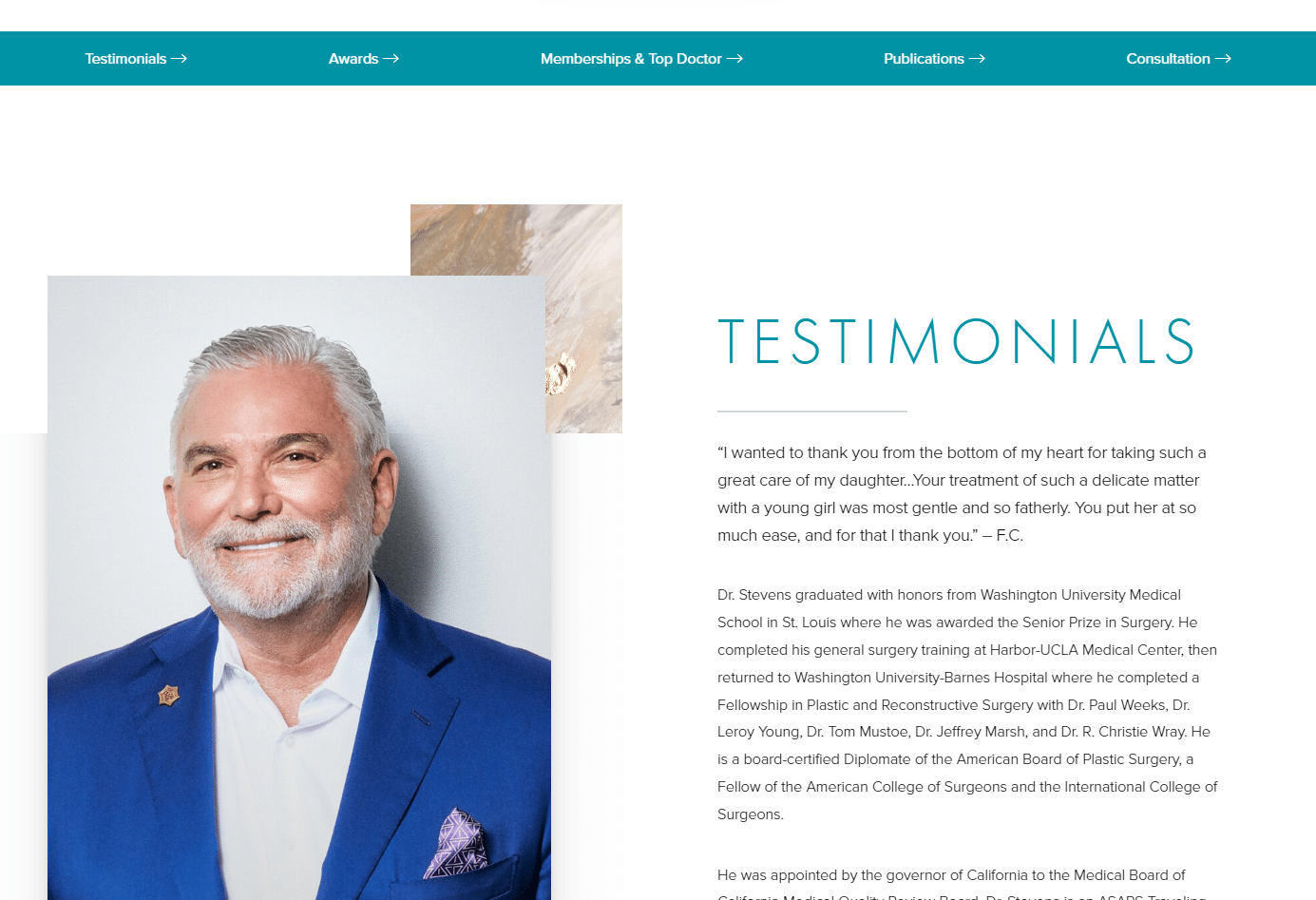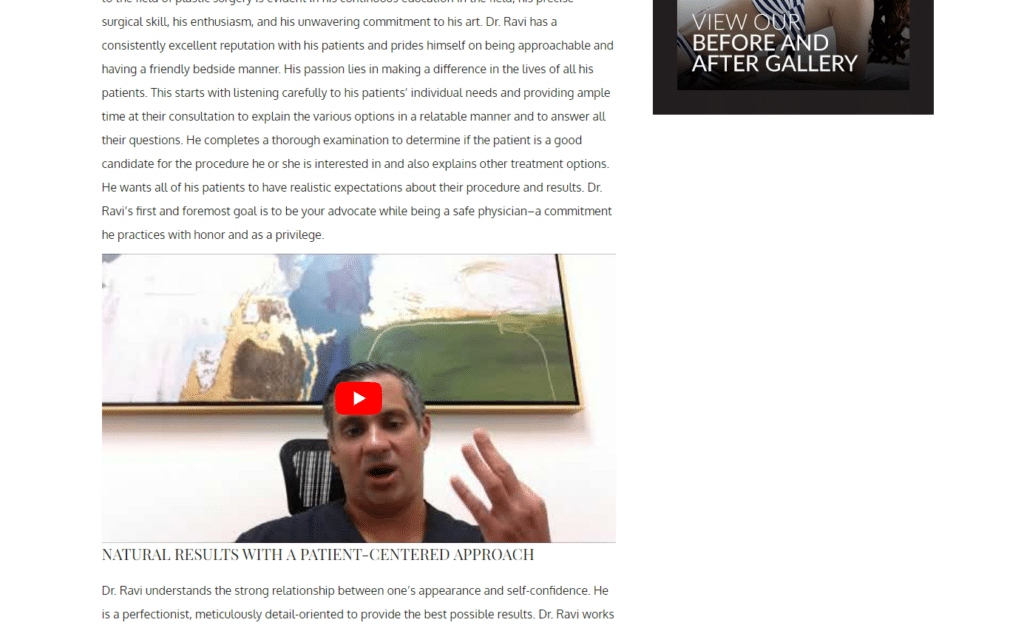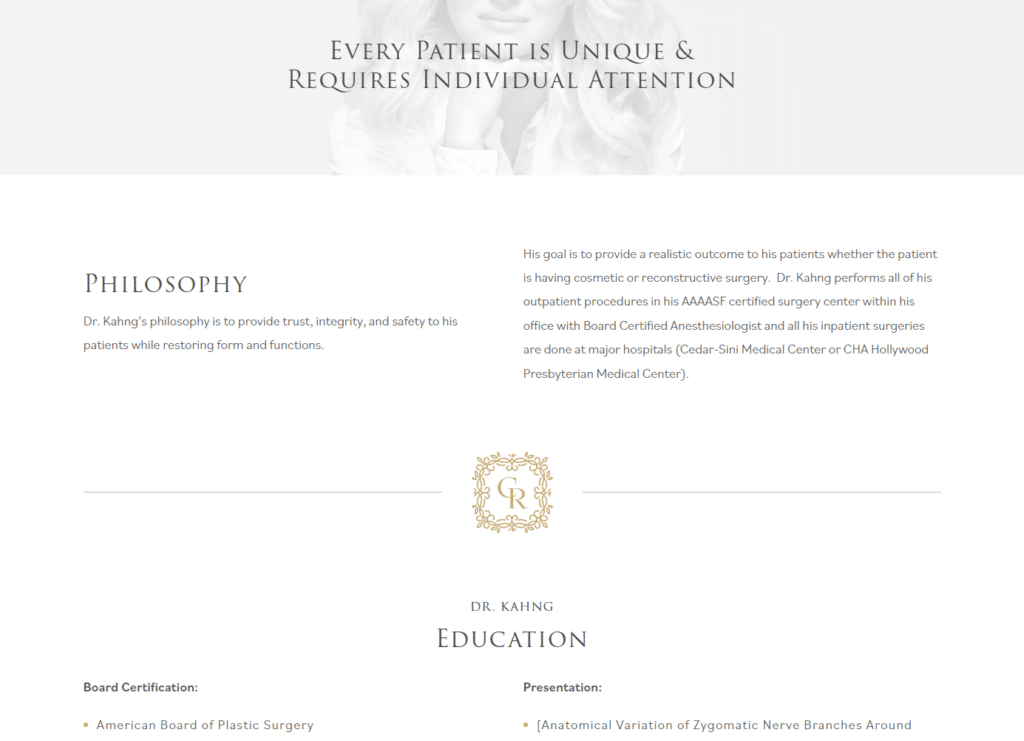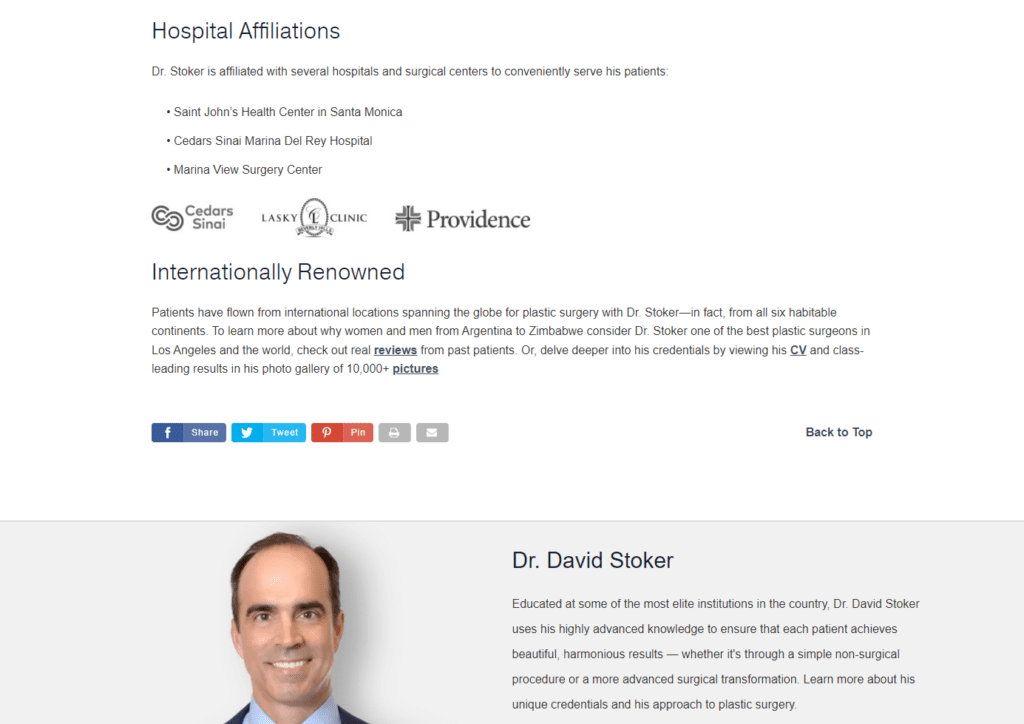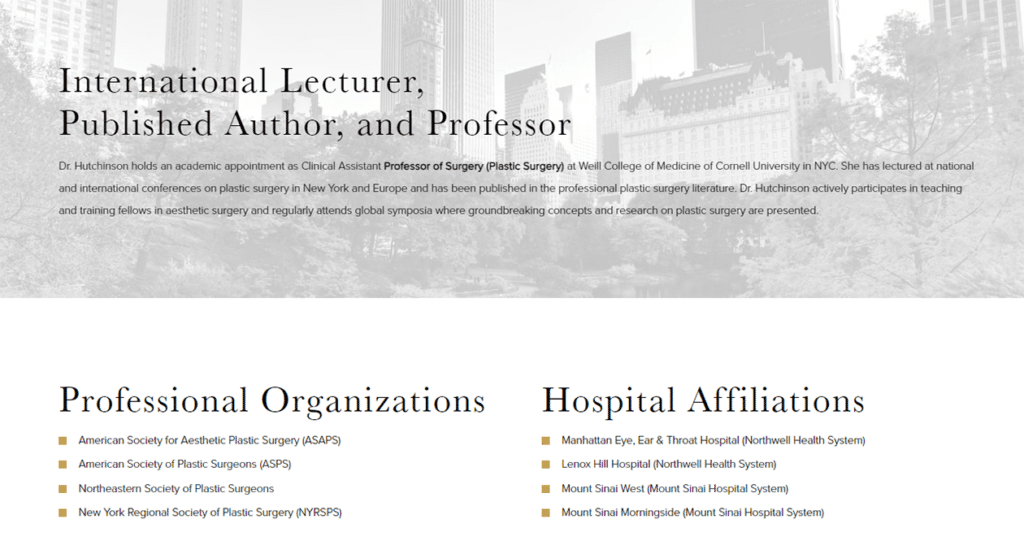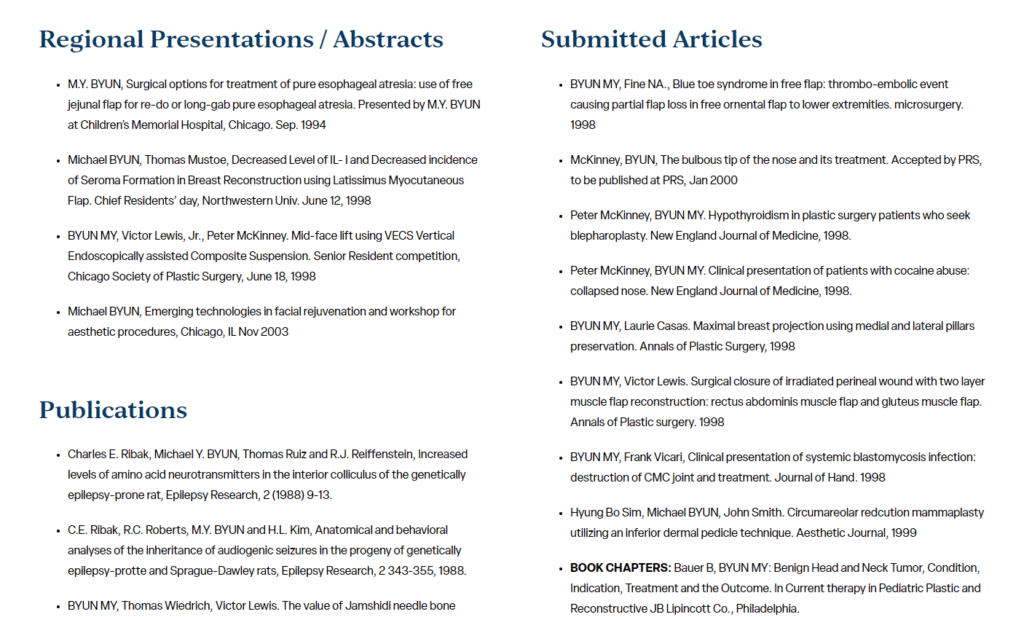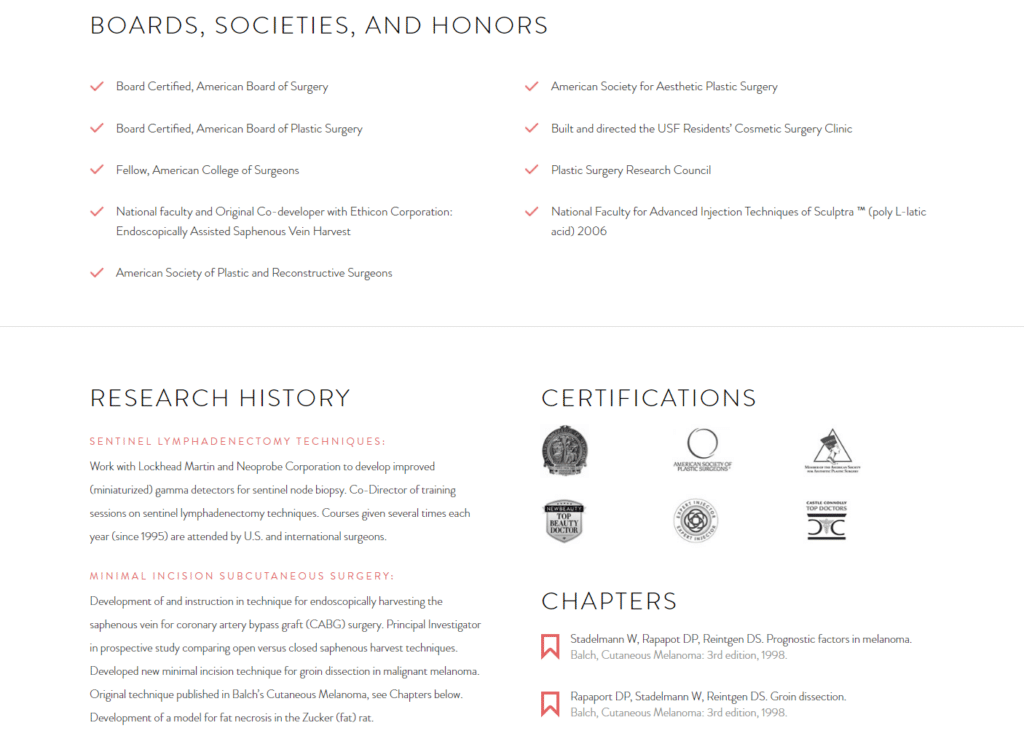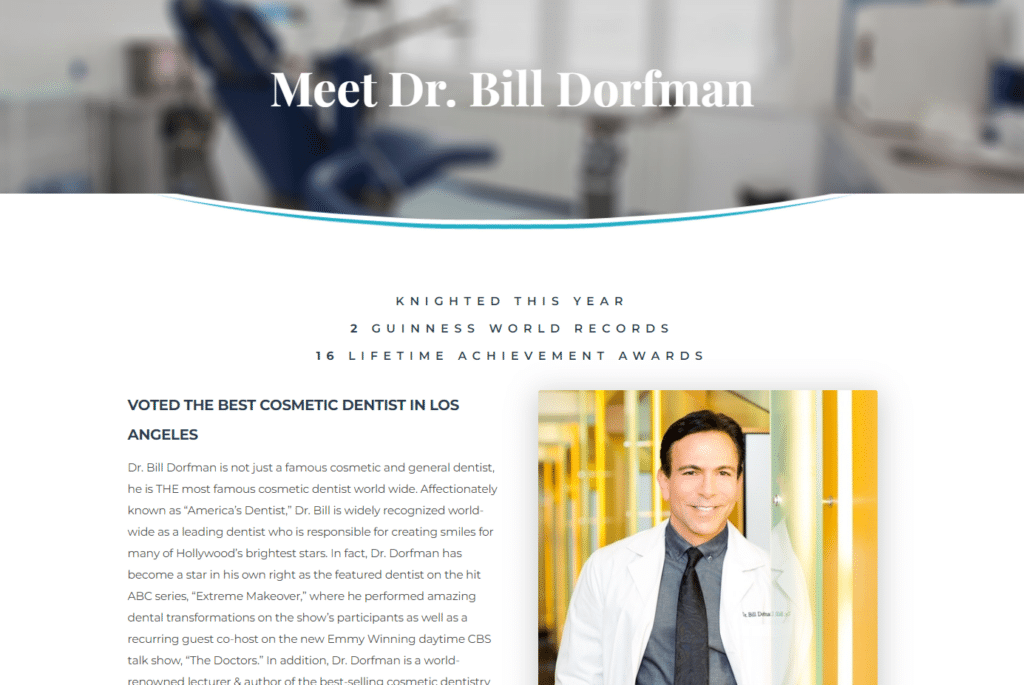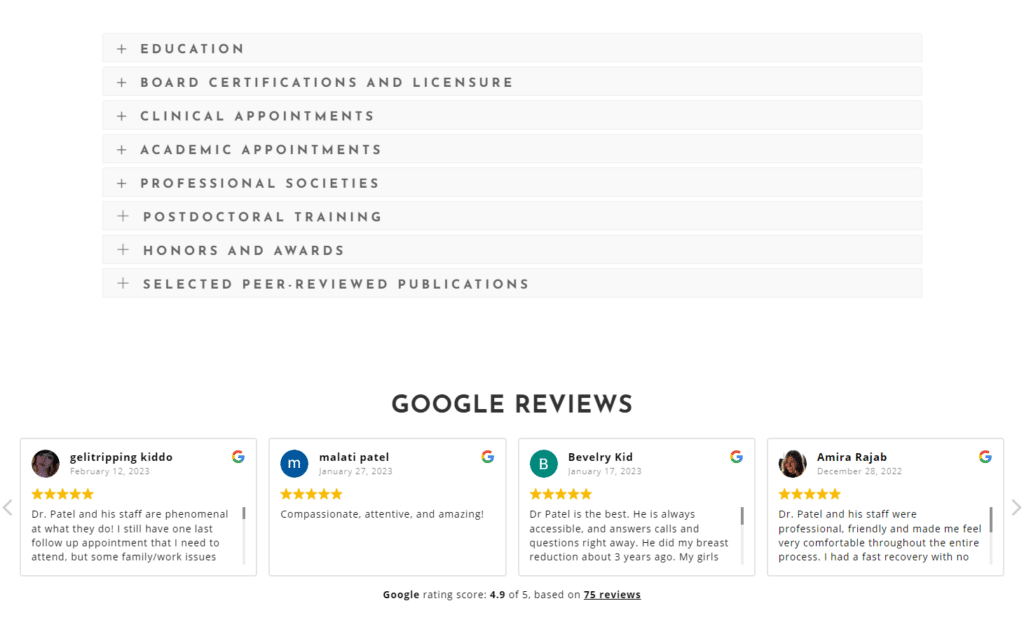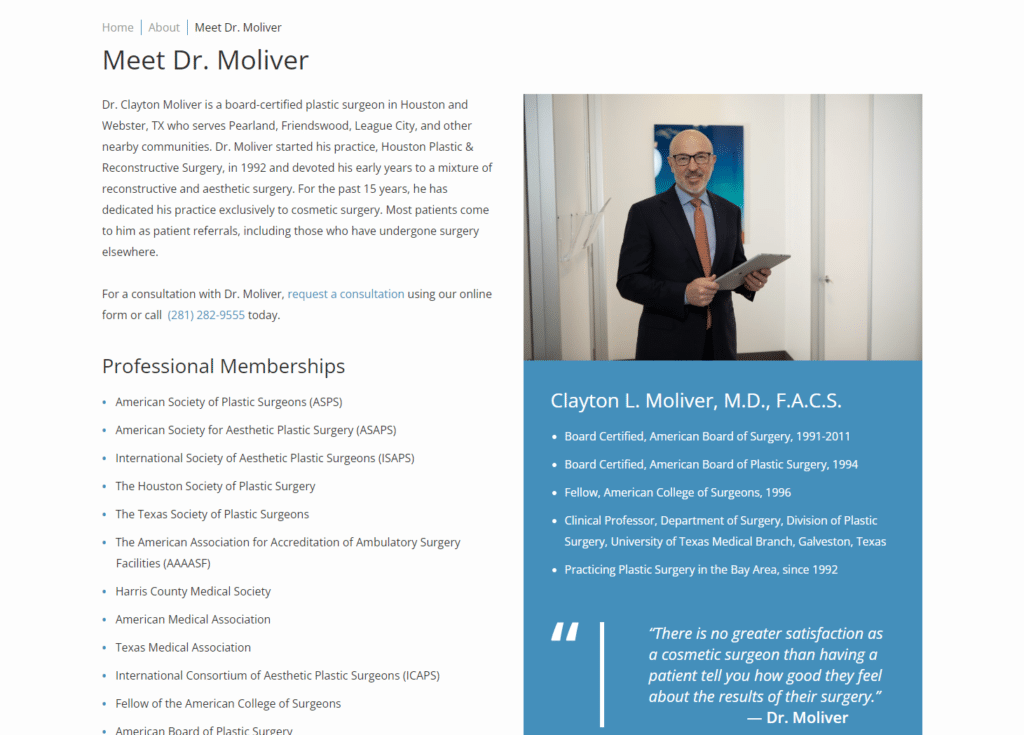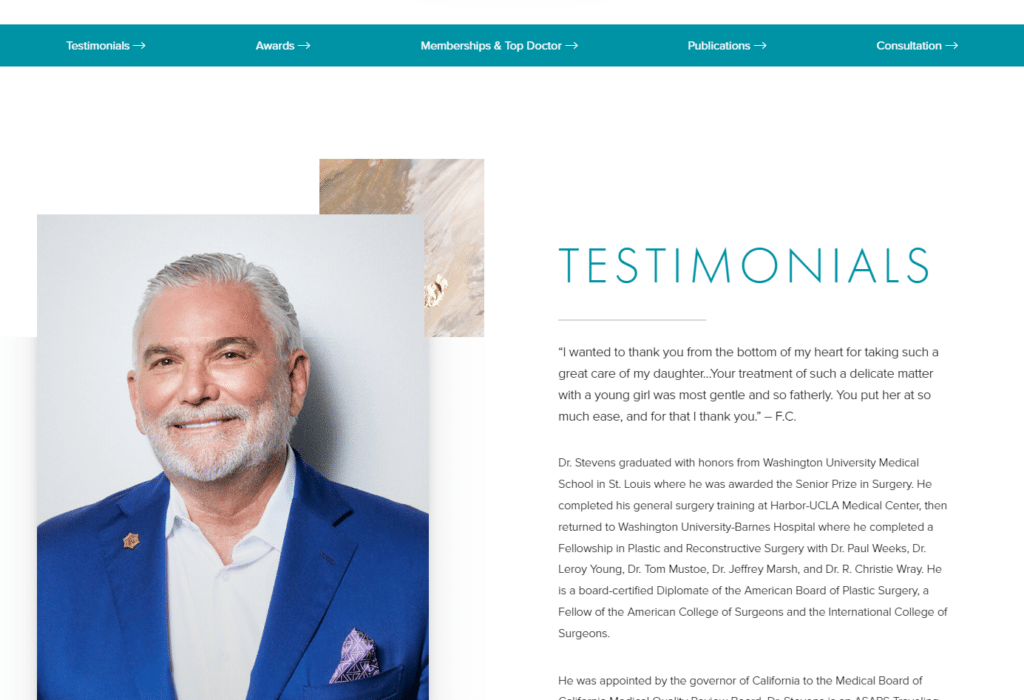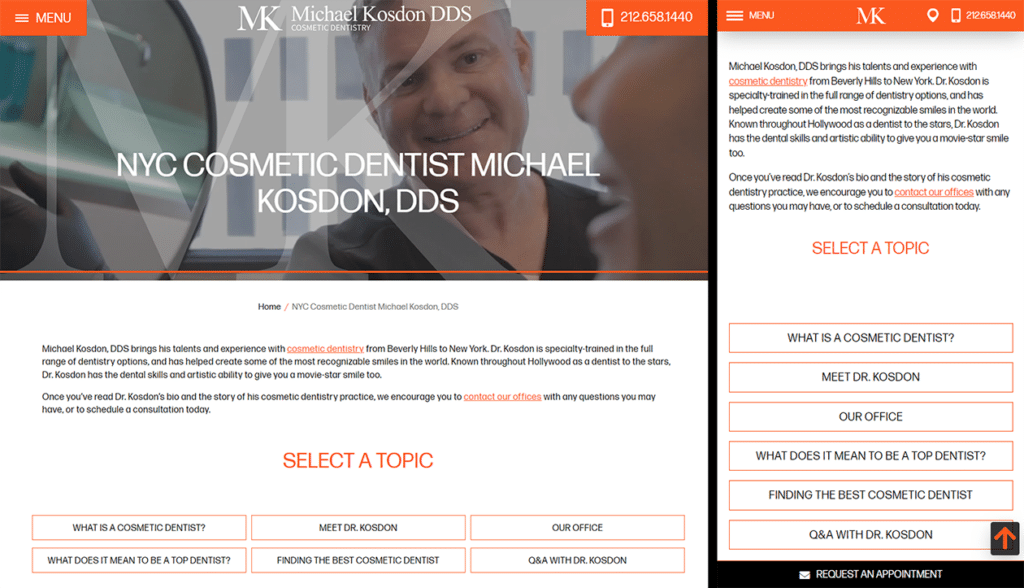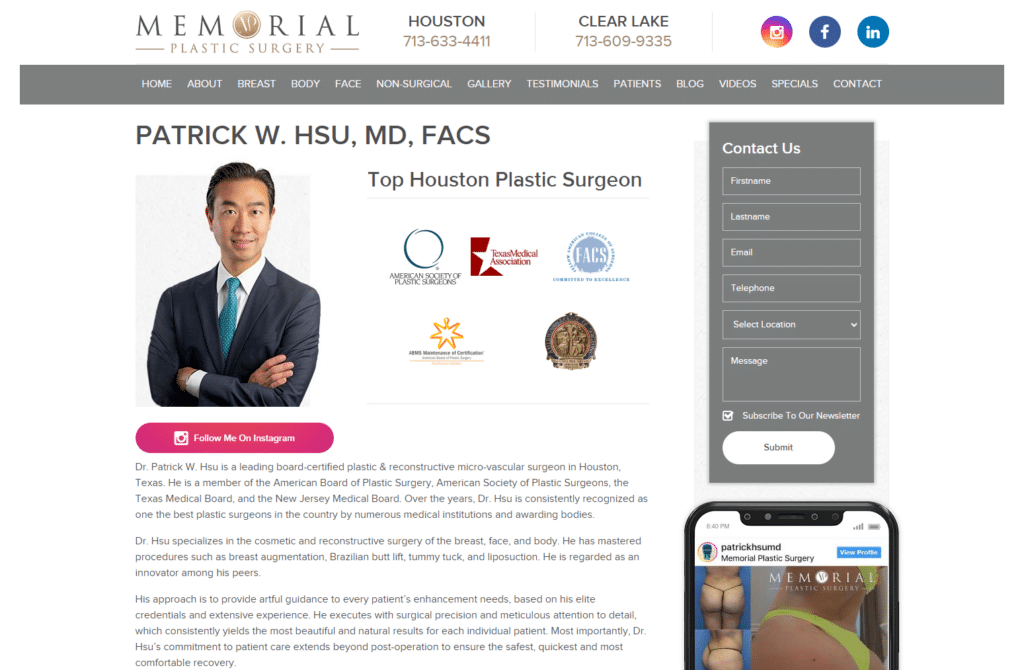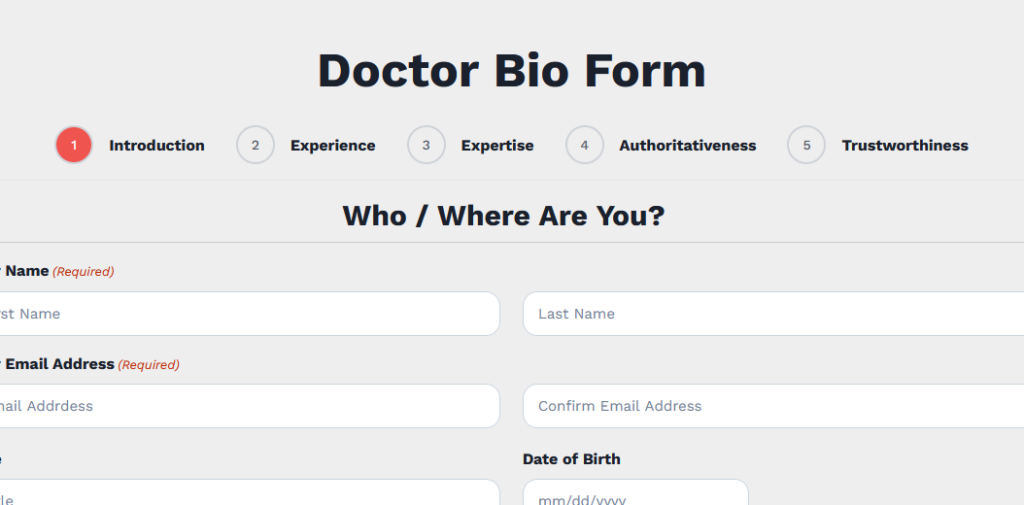As a doctor, your professional bio is one of the most powerful tools you have to showcase your expertise and attract potential patients. In this blog, we will provide you with key elements to include in a well-crafted physician bio and showcase some doctor bio examples that do a great job of using these elements.
We analyzed bio page of doctors from some of the best ranking websites in the most competitive markets, such as New York City, Chicago, Las Angeles and Houston. We also looked at Dental, Ophthalmology, Cosmetic, Dermatology, and Med Spa practices.
Here are our findings. Get ready to learn from doctors who are doing website biographies right!
The Importance of a Well-Crafted Doctor’s Bio
A well-crafted doctor bio is crucial in establishing trust and credibility with potential patients. This is essential for any practice that takes Doctor Reputation Management and Marketing seriously.
- It serves as a platform to showcase a physician’s expertise and experience in specific practice areas.
- Including personal information and interests can create a more personal connection with prospective patients.
- A concise and well-organized bio makes it easier for potential patients to find relevant information quickly.
- Regularly updating and maintaining the bio demonstrates ongoing professional growth.
8 Key Elements to Include in a Doctor’s Bio
When creating your doctor biography, it is crucial to incorporate essential components that will differentiate it and adhere to Google’s E-E-A-T guidelines, which represent Experience, Expertise, Authoritativeness, and Trustworthiness. Adhering to these guidelines not only enhances your profile’s chances of improved rankings in Google but also improves the performance of your bio page, leading to more phone calls, form submissions, etc.
1. Add Your Personal Touch with Hobbies, Values, and Philosophies
Connect with your patients on a personal level by sharing your hobbies. This is a great way to build rapport and show them that you are more than just a doctor. In addition, highlighting your values and philosophies allows patients to understand your approach to healthcare and what sets you apart.
Incorporating patient testimonials is a powerful way to demonstrate the positive impact you’ve had on their lives. Using storytelling techniques engages readers and makes your bio memorable. Lastly, make sure to emphasize your dedication to providing compassionate care.
Dr. Rick Kline – Uses a picture of his family and video of a media appearance to help personalize his bio page.
Dr. Ravi Somayazula – Uses a video made with a webcam or cell phone to add personalization to his bio page.
Dr. David Kahng – Highlights his personal philosophy and uses video to add personalization to the bio.
2. Demonstrate Your Medical Experience
Showcasing years of experience is a great way to instill confidence in patients. Research and involvement in clinical trials show dedication to advancing healthcare. By incorporating these elements into your doctor bio, you are providing a clear call to patients that you are knowledgeable and experienced in your field.
Enhance your bio by sharing any notable outcomes or achievements to help demonstrate your experience. Don’t forget to mention any hospital affiliations you may have.
Dr. David Stoker – Emphasizes his hospital affiliations and uses their logos.
3. Emphasize Medical Areas & Procedures You Specialize In
To attract patients seeking specialized medical help, clearly state the areas of medicine you specialize in. Highlight specific procedures or treatments that you excel in, along with any sub-specializations or areas of focus within your field. By explaining how your expertise can benefit patients seeking specialized care, you can showcase the value you bring to their health journey.
Dr. Vlad Fedin – Showcases his areas of expertise to highlight his specialties.
4. Highlight Your Education and Training
Highlighting your education and training is a crucial aspect of your doctor bio. Mentioning relevant degrees, certifications, and completed training programs showcases your expertise as a physician. If you have undergone any specialized training or fellowships in your field, be sure to emphasize them. By emphasizing your education and training, you can demonstrate your commitment to continuous learning and how it contributes to your expertise as a physician.
Dr. Robert Maloney – Lays out his education and training info on an easy-to-read grid.
5. List Your Representative Work and Publications
Including a list of publications you have authored or co-authored is a great way to demonstrate your involvement in advancing medical knowledge and practice. You can also highlight any research studies or clinical trials you have contributed to.
It is important to mention any medical journals where your work has been published as well. By listing your representative work and publications, you can effectively demonstrate your active role in advancing healthcare.
Dr. Olivia Hutchinson – Highlights her teaching, international lecturing and authorship.
Dr. Michael BYUN – He has very robust content that is extremely skimmable and lists a large amount of representative work and publications.
6. Include Your Speaking Engagements and Media Appearances
Highlighting your participation in speaking engagements and media appearances is a great way to showcase your expertise and influence in the medical community. Whether it’s giving lectures at medical conferences or sharing your knowledge through media interviews, these experiences demonstrate your ability to effectively communicate complex medical concepts to a broader audience.
Remember to include links or references to any podcasts, webinars or interviews you have participated in. By including your speaking engagements and media appearances in your doctor bio, you not only establish your thought leadership but also show your commitment to advancing healthcare through clear communication and engagement with the public.
David Cangello, M.D. – Highlights media appearances and uses logos of media companies.
7. Demonstrate Your Professional Associations and Honors
Highlighting your professional associations and societies is a great way to demonstrate your commitment to the medical community. Mention any leadership roles you have held within these organizations to showcase your involvement and influence. Additionally, including any honors or accolades you have received for your contributions to the medical field can further establish your expertise and credibility.
Showcasing your commitment to professional development and staying connected to your peers is important, so don’t forget to mention any volunteer work or community service related to healthcare. By emphasizing your professional associations and honors, you are establishing yourself as a respected and dedicated physician.
Dr. David Rapaport – Highlights certification and associations he’s a member of.
Dr. Bill Dorfman – Leads with his achievements and honors to differentiate himself from competitors and build trust and credibility.
Dr. Amanda Canto – Highlights her volunteer efforts and community involvement.
8. Patient Feedback: Incorporating Ratings and Reviews
Including positive patient reviews and testimonials not only highlights patient satisfaction but also builds trust with potential patients. Utilize ratings and review platforms to display patient feedback and demonstrate your dedication to their well-being. By encouraging patients to share their experiences and providing links to review sites, you can further enhance your reputation and attract new patients.
Dr. John E. Sherman – Uses the sidebar to show reviews for patients.
Dr. Parit A. Patel – Showcases reviews with review sources, dates and ratings.
Bonus Tips For Your Doctor Bio
Make it Skimmable
To make your doctor bio more skimmable, consider using bullet points or subheadings to highlight key information. Breaking up large paragraphs into shorter, digestible sections can also improve readability. Additionally, using bold or italics to emphasize important details will help draw attention to critical information. Including a brief summary at the beginning of your bio gives readers a quick overview, making it easier for them to find what they’re looking for. Finally, incorporating relevant keywords throughout your bio can help optimize it for search engines. By implementing these techniques, you can create a bio that is easy to scan and navigate.
Dr. Clayton Moliver – Uses headings and bullet points to make it easy to quickly scan his bio.
Keep the Design / Layout Simple
When crafting your doctor bio, it’s essential to keep the design and layout simple for an effective and professional look. Avoid cluttering the page with excessive graphics or images, as they can distract from the main content. Opt for a clean and professional font style and size that is easy to read.
Strategic use of white space can enhance readability and give your bio a more organized appearance. Ensure proper alignment of text and elements for a polished look. Consider using a consistent color scheme that reflects your personal brand.
By keeping the design and layout simple, you can create a visually appealing and user-friendly doctor bio.
Dr. Grant Stevens – Uses anchor links to help users quickly access the information they care about most.
Dr. Cara R. Downey – Utilizes accordion design to use space efficiently for sharing information.
Make It Mobile Responsive
Ensure your doctor bio reaches a wider audience by optimizing it for mobile devices. Use a responsive website design that adapts to different screen sizes, ensuring a seamless user experience. Prioritize essential information and make it easily accessible on smaller screens.
By avoiding large file sizes or complex layouts, you can prevent slow mobile loading times. Test your bio on various mobile devices to ensure it looks and functions correctly. Making your doctor bio mobile responsive is a great way to engage with patients who spend time on their smartphones and tablets.
Dr. Michael Kosdon – Uses mobile responsive design techniques to make the content easier to view on mobile devices.
Maintain and Update Your Physician Bio Regularly
To ensure your physician bio remains accurate and relevant, it’s important to regularly review and update it. Keep track of new accomplishments, awards, or certifications you achieve and add them to your bio. Remove any outdated information or credentials that are no longer relevant. Consider seeking feedback from colleagues or patients to make improvements.
Additionally, maintaining an ongoing record of major milestones or patient success stories can provide valuable content to incorporate into your bio. By regularly updating your physician bio, you can keep it fresh and engaging for your audience.
Displaying Your Individual Contact Info is a Personal Preference
Deciding whether to include your email, phone number or other contact details in your bio is entirely up to you. It’s a personal preference that depends on the level of privacy you desire and the convenience for potential patients.
Some doctors choose to provide alternative methods of contact, such as a contact form on their website, rather than displaying their direct contact information. Having direct contact information on a bio page can lead to an increase in spam.
Whichever option you choose, make sure to regularly monitor and promptly respond to any contact inquiries.
More Doctor Bio Examples
Dr. Daniel Barrett – Has a link to watch him live.
Dr. Patrick W. Hsu – Promotes Instagram account.
Dr. Paul Vitenas – Includes a video tour of the practice.
Helpful Tools & Resources
Google’s latest update to the quality rater guidelines: E-A-T gets an extra E for Experience
Still not sure where to start when writing your biography? Try our free doctor bio form tool! The form:
- Easily guides you through the info you need to satisfy Google’s E-E-A-T Guidelines with your bio.
- Offers save and continue later functionality.
- Takes 15 – 20 minutes to complete.
- Will send the results to your email.
From there, you can use the info gathered to build out profiles on HealthGrades, WebMD, etc.

